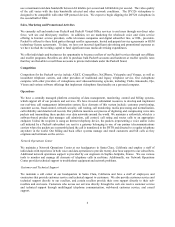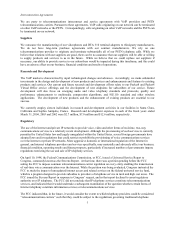8x8 2004 Annual Report Download - page 6
Download and view the complete annual report
Please find page 6 of the 2004 8x8 annual report below. You can navigate through the pages in the report by either clicking on the pages listed below, or by using the keyword search tool below to find specific information within the annual report.3
• They are expensive to build because each subscriber's telephone must be individually connected to the
central office switch, which is usually several miles away from a typical subscriber's location;
• They transmit data at very low rates and resolutions, making them poorly suited for delivering high-fidelity
audio, entertainment-quality video or other rich multimedia content;
• They use dedicated circuits for each telephone call, which allot fixed bandwidth throughout the duration of
each call, whether or not voice is actually being transmitted; and
• They may experience difficulty in providing new or differentiated services or functions, such as video
communications, that the network was not originally designed to accommodate.
Until recently, traditional telephone companies have avoided the use of packet switched networks for transmitting
voice calls due to the potential for poor sound quality attributable to latency issues (delays) and lost packets which
can prevent real-time transmission. Recent improvements in packet switch technology, compression and broadband
access technologies, as well as improved hardware and provisioning techniques, have significantly improved the
quality and usability of packet-switched voice calls.
Packet-switched networks have been built mainly for carrying non real-time data. The advantages of such networks
are their efficiency, flexibility and scalability. Bandwidth is only consumed when needed. Networks can be built in a
variety of configurations to suit the number of users, client/server application requirements and desired availability
of bandwidth, and many terminals can share the same connection to the network. As a result, significantly more
traffic can be transmitted over a packet switched network, such as a home network or the Internet, than a circuit-
switched telephony network. Packet switching technology allows service providers to converge their traditionally
separate voice and data networks and more efficiently utilize their networks by carrying voice, video, fax and data
traffic over the same network. The improved efficiency of packet switching technology creates network cost savings
that can be passed on to the consumer in the form of lower telephony rates.
The exponential growth of the Internet in recent years has proven the scalability of these underlying packet switched
networks. As broadband connectivity, including cable modem and digital subscriber line, or DSL, has become more
available and less expensive, it is now possible for service providers like us to offer voice and video services that run
over these IP networks to businesses and consumers. Providing such services has the potential to both substantially
lower the cost of telephone service and equipment costs to these customers and to increase the breadth of features
available to the end-user. Services like full-motion, two-way video are now supported by the bandwidth spectrum
commonly available to broadband customers, whether business or residential.
Our Strategy
Our objective is to build a profitable, worldwide telephone company that provides rich media IP services with
minimum infrastructure costs. We intend to bring the best possible voice and video products and services, at an
affordable price, to consumers and businesses and enhance the ways in which these customers communicate.
Our strategy to accomplish this objective is to:
• Capitalize on our technological expertise to introduce new products and features. Over the past ten
years, we have developed or acquired several core technologies that form the backbone of our video
and voice over IP service and which we intend to use to develop product enhancements and future
products. We developed the endpoint technologies used to provide video and voice service, and
control the software and firmware that run these endpoint devices. As a result, we are able to update
customer endpoints without any third party asistance.
• Offer the best possible service and support to our customers with a world class customer support
organization. We have established a call center and customer support group at our headquarters in
Santa Clara, California. In the second quarter of fiscal 2005, we expect to be providing 24-by-7
support to our worldwide subscriber base. We also expect to make significant upgrades to our



















